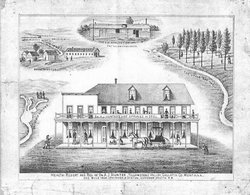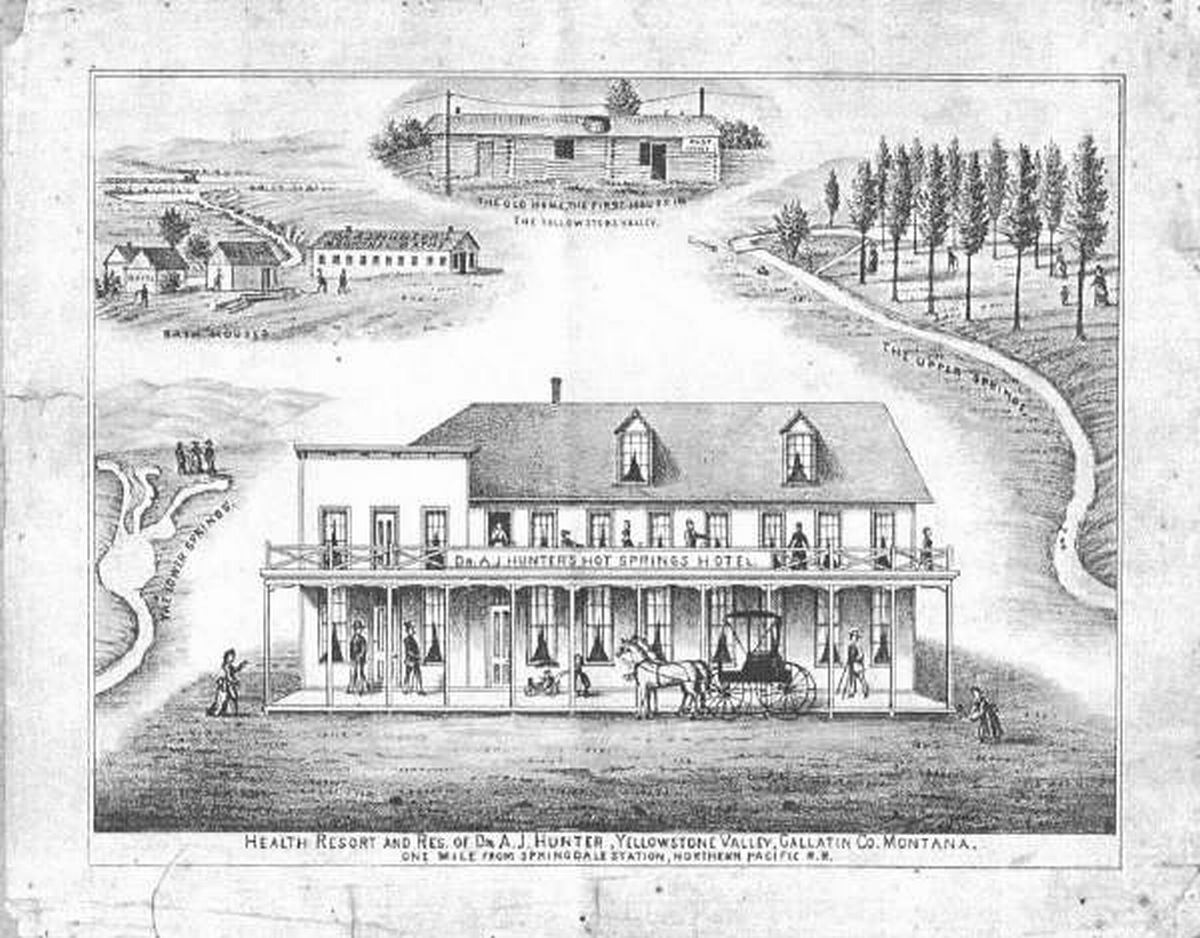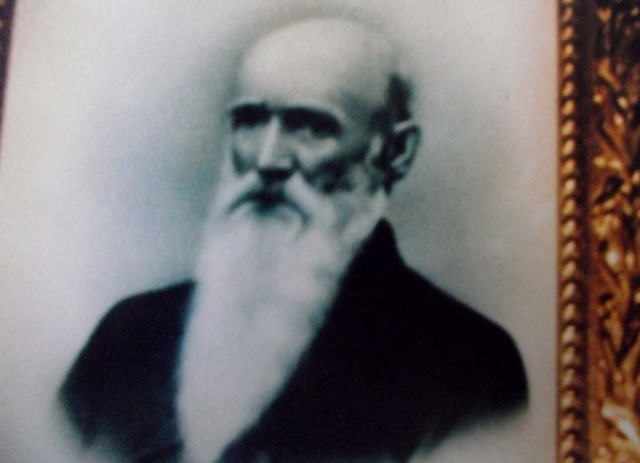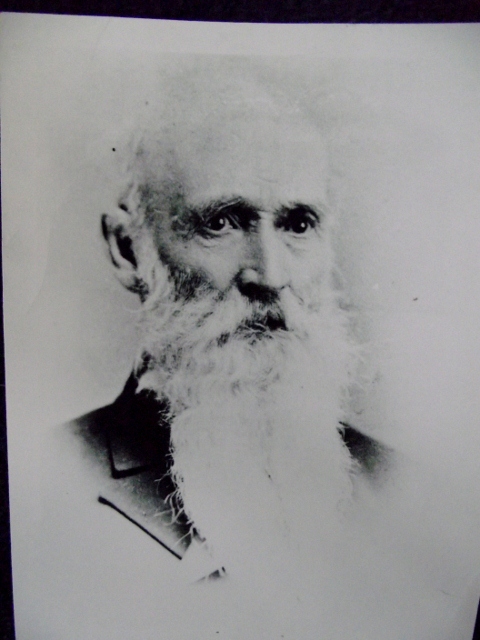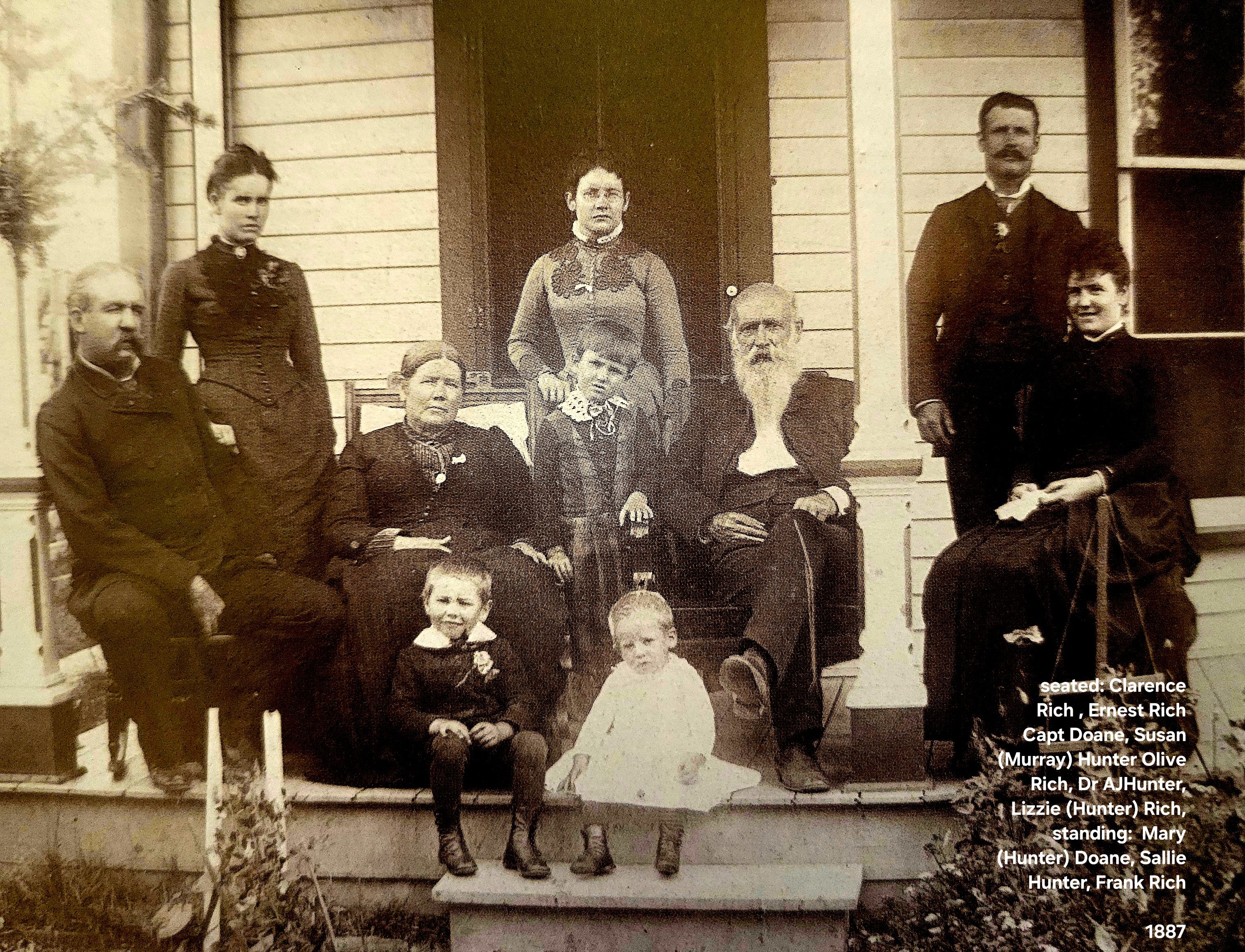***** *****
Andrew Jackson was born in Virginia, the youngest of at least 15 children born to Sarah "Sallie" (Price) and John Hunter.
In 1818, when he was 3, his Dad took a land grant in Kentucky (possibly for services during the War of 1812), and moved the family from Cumberland Co. Va through the Cumberland Gap to Cumberland Co Ky. They settled there on Judio Creek and raised tobacco.
Three years later in 1821, his Dad died unexpectedly. We've been told the male children were placed with "prominent men in the community" after John's Death. Andrew J and William with doctors and their brother Shores with a saddle maker. His Mom Sarah continued on at the farm with help from neighbors and his sister Charity.
Many of the Cumberland records have been destroyed, but we do know in 1838 Andrew was a doctor and married to Lucy Ann Philpott, daughter of Sidney (Monroe) and John Philpott. The Philpotts were neighbors to the Hunters. Both Lucy Ann and Andrew are mentioned in the will of John Philpott after his death in 1839.
According to the 1850 Census records for Cumberland Co, Ky, Lucy Ann and Andrew Jackson had three children;
A J 1840 ~ 1854
Samuel J 1845 ~ 1933
Ardell 1848 ~ 1854
They lived in Cumberland Co until Lucy Ann, A J, and Ardell died in an epidemic in 1854.
After Lucy Ann's death Andrew took a job as railroad physician and that job took him to Arkansas, Illinois, and Missouri. Samuel stayed behind in Kentucky with family.
In Missouri he met Susannah "Susan" Celeste Murray daughter of Elizabeth (Urie) and John Murray. Both of Susan's parent had died from cholera and she was taking care of her younger siblings; Thomas, Alverda, and Commodore. Dr Hunter and Susan were married 12 Oct 1858 in Missouri. They lived in Missouri and he continued to work as a physician for the railroad. Their first child was born there in 1859, Mary Lee. Davis Bouregard joined the family there on 25 Feb 1861.
With the out break of the Civil War, Dr Hunter volunteered for the South. After passing his medical boards, Dr Hunter was commissioned Asst. Surgeon on Sept. 11, 1861, by The Confederate States, and assigned first to the 6th La Vol, also known as "Lee's Tigers".
Every year of the war the doctors were assigned as surgeons and assistant surgeons where needed. Winters were spent pulled back to more stationary hospital units instead of field hospitals. Winters found Dr Hunter at Orange Court House Hospital in Virginia. During those months he would also take furlough and return to Missouri to check on Susan and Family. After Lee's Tigers were all but wiped out in battles, Dr Hunter was next assigned to the North Carolina 38th Vol. for the spring/summer campaign of 1862. After another winter at Orange Court House in the spring of 1863 he was assigned to Stuart's Horse Artillery Cavalry. During that campaign, in Aug of 1863, he was captured at the retreat of The Battle Gettysburg along with 7,000 other medical personal. They were sent to Ft McHenry, MD (the population changed from 175 to over 7,000) With winter coming they offered the medical personal the choice of sworn allegiance back to the United States and freedom. Dr Hunter chose that option and in Nov of 1863 was mustered out at Fortress Monroe. He started his trip back to Missouri to Susan and his family.
"Many of the surgeons of the Civil War had never witnessed a major amputation when they joined their regiments; very few of them had treated gunshot wounds."
- Former Assistant Surgeon G.W.H. Kemper, 17th Indiana Inf.
Most of the surgeons who plied the medical trade in the armies had little to no experience with the horrific injuries they would see between 1861 and 1865. The terrible carnage they witnessed, the overwhelming number of wounded men they treated, and the experienced hands they developed ultimately changed the face of American medicine.
The surgeons, assistant surgeons, and hospital stewards of the armies took the lessons they learned and returned to life as doctors in the civilian world. Following the war, they numbered among the most experienced surgeons in the world.
Missouri was torn during the war years with North/South loyalties. When Dr Hunter returned home in early 1864 he found his home burned and nothing left. Another daughter had joined the family; Lizzie Kate Longstreet, during the war years. Also, during that time Susan had been put in jail for her southern sympathies. After being told to hush her southern brat, she swore to give all of her children Southern General's names. The family felt they had no choice but to leave and by April had a wagon and a team of Missouri mules. Dr Hunter (49), Susan (28), Mary (5), Davis (3), Lizzie (2), and Susan's 16 year old brother Commodore loaded up what they had and headed west to Oregon.
They were told to trade their mules for oxen to stop them from being taken by the Indians. Their oxen changed their travel speed and limited them to an Oxen Train and a maximum of 12 miles a day. They were a train of 32 which included 2 women and the 3 Hunter children.
In Nebraska the train met John Bozeman and he talked to all of them of the "New Montana Territory" and the gold found in Virginia City. His new Bozeman Trail would cut weeks off the old travel time. The decision was made and the train headed to Montana. They were following the Bozeman Trail days behind the horse/mule train that John Bozeman was leading. It was a tough trip. Unknown territory with sagebrush as tall as men, with the constant threat of Indians. Susan said the water crossings became a challenge after a wagon tipped in deep water. Susan and Dr Hunter were the only ones who could swim, so one of them would tie a rope around their waist and wade across to see how deep the water was and where it was safe to cross. In August they made it as far as some hot springs close to the Yellowstone River, near present day Livingston, Mt. One of the party acidently shot himself. The train went on toward Bozeman and Virginia City, leaving the Hunter wagon behind to care for the man. He only lived a few days and after his death the Hunters continued on stopping in Bozeman and then on to Virginia City. They arrived there in Sept of 1864. Years later Dr Hunter's daughters told very different stories of their first winter in Montana. Mary insisted that "father found us a fine log home". Lizzie simply said "we lived in a tent and tacked hides to the walls for warmth". Virginia City's population had changed from 4,000 in April to over 16,000 in Sept. History says all wood was being used to build and for the use in gold mining. Chances are they really did live in a tent. That first winter in Montana another child was born, on 25 Nov 1864, Thomas Stonewall Jackson "Stoney".
By spring the of 1865, the decision was made to head to the Helena area and possible gold opportunities there. The family started running the Astor House at the ferry crossing on the Missouri at New York Gulch. Newspaper articles in the Helena paper said a "fine meal could be had at Dr Hunter's Hotel, with billiards in the back". Dr Hunter was still able to mine for gold. Frostbite was a constant threat and Dr Hunter became known as a doctor that could treat severe frostbite without amputation and was called away frequently for that. He also served as a judge, and acting governor Meagher appointed him commissioner for schools and a representative for the constitutional congress for Montana Territory. While Living in York, Susan and Dr Hunter had twin girls that died at birth in 1865 and a daughter Montana Queen Hunter born Nov 4, died Nov 10, 1866.
By Nov of 1867 the family was running the Canyon House at the ferry crossing on the Missouri at Canyon Ferry which was the crossing for Confederate Gulch and Diamond City. While running the hotel Dr Hunter also worked his claim at Confederate Gulch. While living there 2 more daughters were born; Sallie Jane Price 27 Nov 1867 and Emma Sidney Johnson 24 Oct 1869.
In the spring of 1870 Dr Hunter was appointed County Physician for Gallatin Co and Agency Dr for the Crow Indians. ( The family moved to Bozeman.
Because there was no survey, Dr Hunter filed "squatters rights" to the piece of land they had stopped at in 1864 with the hot springs. When he had worked for the railroad in Arkansas, he had seen the possibilities of healing with hot sulpher water and thought of using it again.
"Squatters Rights" demanded yearly land improvement and time was spent split between Bozeman and Hunters Hot Springs. (roughly a 45 mile trip) While the Crow were friendly, the Sioux were a constant threat. Crops were planted and buildings started as well as a bath house using the hot water. It was a mutiple days trip from Bozeman to the Springs with a crossing on the Yellowstone River on the ferry at Benson's Landing. They avoided the Springs during the Sioux hunting times when the danger was at the highest. The family worked out a plan, Susan would stand watch on the hill above the Springs with a mirror and could warn the men in the field of danger. The children spent the time in the cabin with Lizzie guard at the door. She was the best shot in the family by age 6. On one of those trips in 1874, while hauling hay, the wagon the children were on tipped over, killing 4 year old Emma and injuring Sallie.
In July 1875 Dr Hunter made the trip to the Springs with his sons, workers and a troop from Ft Ellis. While crossing the Yellowstone the cable on the ferry broke and dumped Stoney and others in the water. Two stories were told that day, one that Sgt Erie swam back to save Stoney, the other that Stoney went back for him. Susan had taught all the kids to swim at the Springs and believed Stoney went back because the Sgt couldn't swim. They both drowned. They looked for them and could find no bodies, and when Susan swore to go look for herself was told they had been found and buried on the banks of the Yellowstone. Still she wondered if he survived and was with the Indians. Because he could speak Crow, Sioux, and English, the Indians had tried to trade for him for a translator.
The Indians had also tried to trade for the girls. They all had aubren-red hair that the Indians believed were "big medicine" and when Mary was 13 they offered 100 good war ponies for her. Fearing for her safety, she was left in Bozeman with family, from that point on, when the family went to the Springs to work.
By 1878, Hunters Hot Springs was considered safe enough for the family to live there year-round and they moved there to live. Dr Hunter petitioned the Territory of Montana to transfer patients to the Springs for treatment and to build their "State Hospital" at the springs to take advantage of the hot water for medical purposes. (Another site was later chosen)
Mary Lee, their oldest daughter married in December of 1878 in Helena to Capt G. C. Doane stationed at Ft Ellis.
On Dec 31 1879, Lizzie Hunter married Franklin Rich at the Springs. After selling his freighting business in Butte, they returned to the Springs and with help from investors, built a second hotel (The Rich Hotel) to house the extra guests.
In 1880 Mary Susan (15), Nancy Jane(13),Carrie Jersusha (11) , Algie Mason (8) and Emma Thomas (6) Brandenburg, children of Susan's sister Alverda, joined them at the Spings to live after the death of both parents in Missouri.
Dr Hunter and extended family ran the Springs until the fall of 1885 when he decided at 70 years old to retire. He leased his hotel and moved to Bozeman. A trip was taken that spring to visit his son, Samuel in Texas.
Dr Hunter and family sold their interests in the Springs in 1886 and all moved to Bozeman.
Daughter, Mary and husband Capt Doane moved in with them when Capt Doane became sick in 1892. After his death Mary lived with them.
Dr Hunter died In Bozeman in 1894.
***** *****
Andrew Jackson was born in Virginia, the youngest of at least 15 children born to Sarah "Sallie" (Price) and John Hunter.
In 1818, when he was 3, his Dad took a land grant in Kentucky (possibly for services during the War of 1812), and moved the family from Cumberland Co. Va through the Cumberland Gap to Cumberland Co Ky. They settled there on Judio Creek and raised tobacco.
Three years later in 1821, his Dad died unexpectedly. We've been told the male children were placed with "prominent men in the community" after John's Death. Andrew J and William with doctors and their brother Shores with a saddle maker. His Mom Sarah continued on at the farm with help from neighbors and his sister Charity.
Many of the Cumberland records have been destroyed, but we do know in 1838 Andrew was a doctor and married to Lucy Ann Philpott, daughter of Sidney (Monroe) and John Philpott. The Philpotts were neighbors to the Hunters. Both Lucy Ann and Andrew are mentioned in the will of John Philpott after his death in 1839.
According to the 1850 Census records for Cumberland Co, Ky, Lucy Ann and Andrew Jackson had three children;
A J 1840 ~ 1854
Samuel J 1845 ~ 1933
Ardell 1848 ~ 1854
They lived in Cumberland Co until Lucy Ann, A J, and Ardell died in an epidemic in 1854.
After Lucy Ann's death Andrew took a job as railroad physician and that job took him to Arkansas, Illinois, and Missouri. Samuel stayed behind in Kentucky with family.
In Missouri he met Susannah "Susan" Celeste Murray daughter of Elizabeth (Urie) and John Murray. Both of Susan's parent had died from cholera and she was taking care of her younger siblings; Thomas, Alverda, and Commodore. Dr Hunter and Susan were married 12 Oct 1858 in Missouri. They lived in Missouri and he continued to work as a physician for the railroad. Their first child was born there in 1859, Mary Lee. Davis Bouregard joined the family there on 25 Feb 1861.
With the out break of the Civil War, Dr Hunter volunteered for the South. After passing his medical boards, Dr Hunter was commissioned Asst. Surgeon on Sept. 11, 1861, by The Confederate States, and assigned first to the 6th La Vol, also known as "Lee's Tigers".
Every year of the war the doctors were assigned as surgeons and assistant surgeons where needed. Winters were spent pulled back to more stationary hospital units instead of field hospitals. Winters found Dr Hunter at Orange Court House Hospital in Virginia. During those months he would also take furlough and return to Missouri to check on Susan and Family. After Lee's Tigers were all but wiped out in battles, Dr Hunter was next assigned to the North Carolina 38th Vol. for the spring/summer campaign of 1862. After another winter at Orange Court House in the spring of 1863 he was assigned to Stuart's Horse Artillery Cavalry. During that campaign, in Aug of 1863, he was captured at the retreat of The Battle Gettysburg along with 7,000 other medical personal. They were sent to Ft McHenry, MD (the population changed from 175 to over 7,000) With winter coming they offered the medical personal the choice of sworn allegiance back to the United States and freedom. Dr Hunter chose that option and in Nov of 1863 was mustered out at Fortress Monroe. He started his trip back to Missouri to Susan and his family.
"Many of the surgeons of the Civil War had never witnessed a major amputation when they joined their regiments; very few of them had treated gunshot wounds."
- Former Assistant Surgeon G.W.H. Kemper, 17th Indiana Inf.
Most of the surgeons who plied the medical trade in the armies had little to no experience with the horrific injuries they would see between 1861 and 1865. The terrible carnage they witnessed, the overwhelming number of wounded men they treated, and the experienced hands they developed ultimately changed the face of American medicine.
The surgeons, assistant surgeons, and hospital stewards of the armies took the lessons they learned and returned to life as doctors in the civilian world. Following the war, they numbered among the most experienced surgeons in the world.
Missouri was torn during the war years with North/South loyalties. When Dr Hunter returned home in early 1864 he found his home burned and nothing left. Another daughter had joined the family; Lizzie Kate Longstreet, during the war years. Also, during that time Susan had been put in jail for her southern sympathies. After being told to hush her southern brat, she swore to give all of her children Southern General's names. The family felt they had no choice but to leave and by April had a wagon and a team of Missouri mules. Dr Hunter (49), Susan (28), Mary (5), Davis (3), Lizzie (2), and Susan's 16 year old brother Commodore loaded up what they had and headed west to Oregon.
They were told to trade their mules for oxen to stop them from being taken by the Indians. Their oxen changed their travel speed and limited them to an Oxen Train and a maximum of 12 miles a day. They were a train of 32 which included 2 women and the 3 Hunter children.
In Nebraska the train met John Bozeman and he talked to all of them of the "New Montana Territory" and the gold found in Virginia City. His new Bozeman Trail would cut weeks off the old travel time. The decision was made and the train headed to Montana. They were following the Bozeman Trail days behind the horse/mule train that John Bozeman was leading. It was a tough trip. Unknown territory with sagebrush as tall as men, with the constant threat of Indians. Susan said the water crossings became a challenge after a wagon tipped in deep water. Susan and Dr Hunter were the only ones who could swim, so one of them would tie a rope around their waist and wade across to see how deep the water was and where it was safe to cross. In August they made it as far as some hot springs close to the Yellowstone River, near present day Livingston, Mt. One of the party acidently shot himself. The train went on toward Bozeman and Virginia City, leaving the Hunter wagon behind to care for the man. He only lived a few days and after his death the Hunters continued on stopping in Bozeman and then on to Virginia City. They arrived there in Sept of 1864. Years later Dr Hunter's daughters told very different stories of their first winter in Montana. Mary insisted that "father found us a fine log home". Lizzie simply said "we lived in a tent and tacked hides to the walls for warmth". Virginia City's population had changed from 4,000 in April to over 16,000 in Sept. History says all wood was being used to build and for the use in gold mining. Chances are they really did live in a tent. That first winter in Montana another child was born, on 25 Nov 1864, Thomas Stonewall Jackson "Stoney".
By spring the of 1865, the decision was made to head to the Helena area and possible gold opportunities there. The family started running the Astor House at the ferry crossing on the Missouri at New York Gulch. Newspaper articles in the Helena paper said a "fine meal could be had at Dr Hunter's Hotel, with billiards in the back". Dr Hunter was still able to mine for gold. Frostbite was a constant threat and Dr Hunter became known as a doctor that could treat severe frostbite without amputation and was called away frequently for that. He also served as a judge, and acting governor Meagher appointed him commissioner for schools and a representative for the constitutional congress for Montana Territory. While Living in York, Susan and Dr Hunter had twin girls that died at birth in 1865 and a daughter Montana Queen Hunter born Nov 4, died Nov 10, 1866.
By Nov of 1867 the family was running the Canyon House at the ferry crossing on the Missouri at Canyon Ferry which was the crossing for Confederate Gulch and Diamond City. While running the hotel Dr Hunter also worked his claim at Confederate Gulch. While living there 2 more daughters were born; Sallie Jane Price 27 Nov 1867 and Emma Sidney Johnson 24 Oct 1869.
In the spring of 1870 Dr Hunter was appointed County Physician for Gallatin Co and Agency Dr for the Crow Indians. ( The family moved to Bozeman.
Because there was no survey, Dr Hunter filed "squatters rights" to the piece of land they had stopped at in 1864 with the hot springs. When he had worked for the railroad in Arkansas, he had seen the possibilities of healing with hot sulpher water and thought of using it again.
"Squatters Rights" demanded yearly land improvement and time was spent split between Bozeman and Hunters Hot Springs. (roughly a 45 mile trip) While the Crow were friendly, the Sioux were a constant threat. Crops were planted and buildings started as well as a bath house using the hot water. It was a mutiple days trip from Bozeman to the Springs with a crossing on the Yellowstone River on the ferry at Benson's Landing. They avoided the Springs during the Sioux hunting times when the danger was at the highest. The family worked out a plan, Susan would stand watch on the hill above the Springs with a mirror and could warn the men in the field of danger. The children spent the time in the cabin with Lizzie guard at the door. She was the best shot in the family by age 6. On one of those trips in 1874, while hauling hay, the wagon the children were on tipped over, killing 4 year old Emma and injuring Sallie.
In July 1875 Dr Hunter made the trip to the Springs with his sons, workers and a troop from Ft Ellis. While crossing the Yellowstone the cable on the ferry broke and dumped Stoney and others in the water. Two stories were told that day, one that Sgt Erie swam back to save Stoney, the other that Stoney went back for him. Susan had taught all the kids to swim at the Springs and believed Stoney went back because the Sgt couldn't swim. They both drowned. They looked for them and could find no bodies, and when Susan swore to go look for herself was told they had been found and buried on the banks of the Yellowstone. Still she wondered if he survived and was with the Indians. Because he could speak Crow, Sioux, and English, the Indians had tried to trade for him for a translator.
The Indians had also tried to trade for the girls. They all had aubren-red hair that the Indians believed were "big medicine" and when Mary was 13 they offered 100 good war ponies for her. Fearing for her safety, she was left in Bozeman with family, from that point on, when the family went to the Springs to work.
By 1878, Hunters Hot Springs was considered safe enough for the family to live there year-round and they moved there to live. Dr Hunter petitioned the Territory of Montana to transfer patients to the Springs for treatment and to build their "State Hospital" at the springs to take advantage of the hot water for medical purposes. (Another site was later chosen)
Mary Lee, their oldest daughter married in December of 1878 in Helena to Capt G. C. Doane stationed at Ft Ellis.
On Dec 31 1879, Lizzie Hunter married Franklin Rich at the Springs. After selling his freighting business in Butte, they returned to the Springs and with help from investors, built a second hotel (The Rich Hotel) to house the extra guests.
In 1880 Mary Susan (15), Nancy Jane(13),Carrie Jersusha (11) , Algie Mason (8) and Emma Thomas (6) Brandenburg, children of Susan's sister Alverda, joined them at the Spings to live after the death of both parents in Missouri.
Dr Hunter and extended family ran the Springs until the fall of 1885 when he decided at 70 years old to retire. He leased his hotel and moved to Bozeman. A trip was taken that spring to visit his son, Samuel in Texas.
Dr Hunter and family sold their interests in the Springs in 1886 and all moved to Bozeman.
Daughter, Mary and husband Capt Doane moved in with them when Capt Doane became sick in 1892. After his death Mary lived with them.
Dr Hunter died In Bozeman in 1894.
Family Members
-
Ariana J Hunter Tealey
1840–1857
-
![]()
Samuel Jackson Hunter
1845–1937
-
Ardell Hunter
1848–1857
-
![]()
Mary Lee Hunter Doane
1859–1952
-
![]()
Davis Boureguard Hunter
1861–1930
-
![]()
Lizzie Kate Longstreet Hunter Rich
1863–1947
-
![]()
Thomas Stonewall Jackson "Stoney" Hunter
1864–1875
-
![]()
Twin Baby Girls Hunter
1865–1865
-
![]()
Montana Queen Hunter
1866–1866
-
![]()
Sallie Jane Price Hunter Janes
1867–1938
-
![]()
Emma Sidney Johnson Hunter
1869–1874
